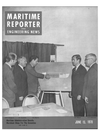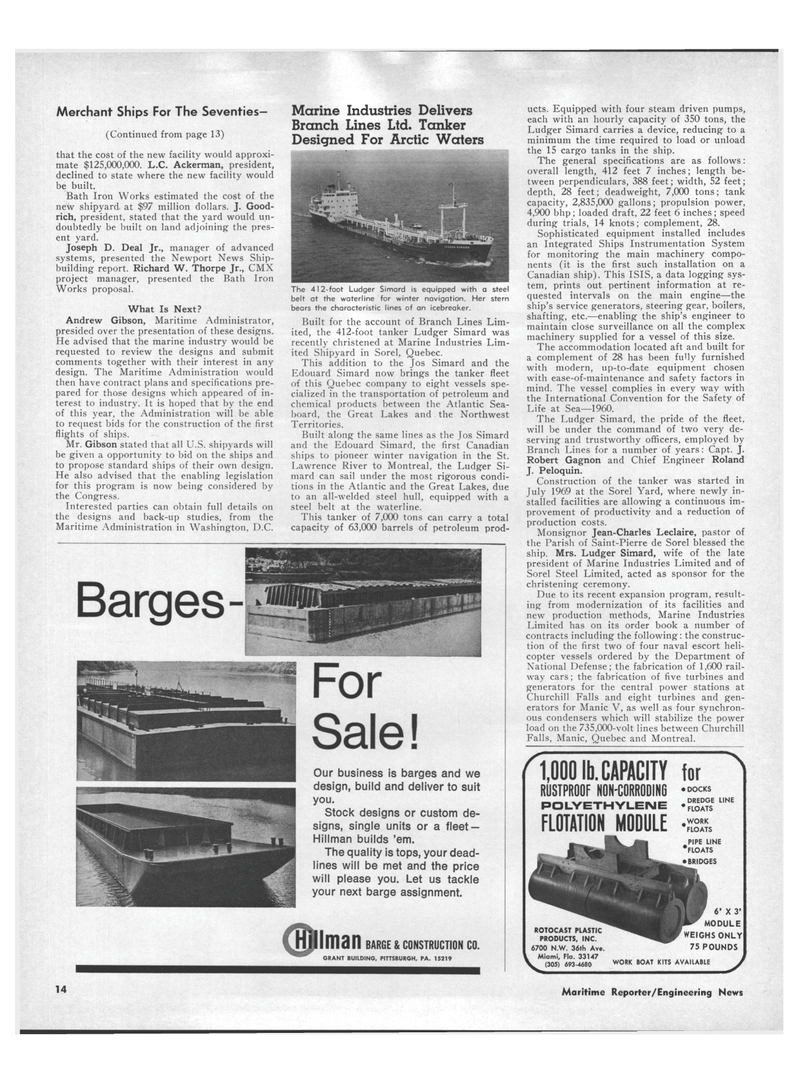
Page 12: of Maritime Reporter Magazine (June 15, 1970)
Read this page in Pdf, Flash or Html5 edition of June 15, 1970 Maritime Reporter Magazine
ucts. Equipped with four steam driven pumps, each with an hourly capacity of 350 tons, the
Ludger Simard carries a device, reducing to a minimum the time required to load or unload the 15 cargo tanks in the ship.
The general specifications are as follows: overall length, 412 feet 7 inches; length be- tween perpendiculars, 388 feet; width, 52 feet; depth, 28 feet; deadweight, 7,000 tons; tank capacity, 2,835,000 gallons; propulsion power, 4,900 bhp; loaded draft, 22 feet 6 inches; speed during trials, 14 knots; complement, 28.
Sophisticated equipment installed includes an Integrated Ships Instrumentation System for monitoring the main machinery compo- nents (it is the first such installation on a
Canadian ship). This ISIS, a data logging sys- tem, prints out pertinent information at re- quested intervals on the main engine—the ship's service generators, steering gear, boilers, shafting, etc.—enabling the ship's engineer to maintain close surveillance on all the complex machinery supplied for a vessel of this size.
The accommodation located aft and built for a complement of 28 has been fully furnished with modern, up-to-date equipment chosen with ease-of-maintenance and safety factors in mind. The vessel complies in every way with the International Convention for the Safety of
Life at Sea—1960.
The Ludger Simard, the pride of the fleet, will be under the command of two very de- serving and trustworthy officers, employed by
Branch Lines for a number of years: Capt. J.
Robert Gagnon and Chief Engineer Roland
J. Peloquin.
Construction of the tanker was started in
July 1969 at the Sorel Yard, where newly in- stalled facilities are allowing a continuous im- provement of productivity and a reduction of production costs.
Monsignor Jean-Charles Leclaire, pastor of the Parish of Saint-Pierre de Sorel blessed the ship. Mrs. Ludger Simard, wife of the late president of Marine Industries Limited and of
Sorel Steel Limited, acted as sponsor for the christening ceremony.
Due to its recent expansion program, result- ing from modernization of its facilities and new production methods, Marine Industries
Limited has on its order book a number of contracts including the following: the construc- tion of the first two of four naval escort heli- copter vessels ordered by the Department of
National Defense; the fabrication of 1,600 rail- way cars; the fabrication of five turbines and generators for the central power stations at
Churchill Falls and eight turbines and gen- erators for Manic V, as well as four synchron- ous condensers which will stabilize the power load on the 735,000-volt lines between Churchill
Falls, Manic, Quebec and Montreal. 1,000 lb. CAPACITY for
RUSTPROOF NON-CORRODINO ">°«s
POLYETHYLENE l,NE
FLOTATION MOOOLE -ss
Merchant Ships For The Seventies- (Continued from page 13) that the cost of the new facility would approxi- mate $125,000,000. L.C. Ackerman, president, declined to state where the new facility would be built.
Bath Iron Works estimated the cost of the new shipyard at $97 million dollars. J. Good- rich, president, stated that the yard would un- doubtedly be built on land adjoining the pres- ent yard.
Joseph D. Deal Jr., manager of advanced systems, presented the Newport News Ship- building report. Richard W. Thorpe Jr., CMX project manager, presented the Bath Iron
Works proposal.
What Is Next?
Andrew Gibson, Maritime Administrator, presided over the presentation of these designs.
He advised that the marine industry would be requested to review the designs and submit comments together with their interest in any design. The Maritime Administration would then have contract plans and specifications pre- pared for those designs which appeared of in- terest to industry. It is hoped that by the end of this year, the Administration will be able to request bids for the construction of the first flights of ships.
Mr. Gibson stated that all U.S. shipyards will be given a opportunity to bid on the ships and to propose standard ships of their own design.
He also advised that the enabling legislation for this program is now being considered by the Congress.
Interested parties can obtain full details on the designs and back-up studies, from the
Maritime Administration in Washington, D.C.
Barges-
Marine Industries Delivers
Branch Lines Ltd. Tanker
Designed For Arctic Waters
The 412-foot Ludger Simard is equipped with a steel belt at the waterline for winter navigation. Her stern bears the characteristic lines of an icebreaker.
Built for the account of Branch Lines Lim- ited, the 412-foot tanker Ludger Simard was recently christened at Marine Industries Lim- ited Shipyard in Sorel, Quebec.
This addition to the Jos Simard and the
Edouard Simard now brings the tanker fleet of this Quebec company to eight vessels spe- cialized in the transportation of petroleum and chemical products between the Atlantic Sea- board, the Great Lakes and the Northwest
Territories.
Built along the same lines as the Jos Simard and the Edouard Simard, the first Canadian ships to pioneer winter navigation in the St.
Lawrence River to Montreal, the Ludger Si- mard can sail under the most rigorous condi- tions in the Atlantic and the Great Lakes, due to an all-welded steel hull, equipped with a steel belt at the waterline.
This tanker of 7,000 tons can carry a total capacity of 63,000 barrels of petroleum prod-
For
Sale!
Our business is barges and we design, build and deliver to suit you.
Stock designs or custom de- signs, single units or a fleet —
Hillman builds 'em.
The quality is tops, your dead- lines will be met and the price will please you. Let us tackle your next barge assignment. ®lman ro A Ilit Dimr
BARGE & CONSTRUCTION CO.
GRANT BUILDING, PITTSBURGH, PA. 15219
PIPE LINE •FLOATS • BRIDGES
ROTOCAST PLASTIC
PRODUCTS, INC. 6700 N.W. 36th Ave.
Miami, Fla. 33147 ^ (305) 693-4680
MODULE
WEIGHS ONLY 75 POUNDS
WORK BOAT KITS AVAILABLE 14 Maritime Reporter/Engineering News

 11
11

 13
13
